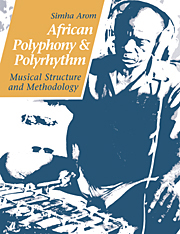Book contents
- Frontmatter
- Contents
- List of illustrations
- Foreword by György Ligeti
- Preface
- Acknowledgements
- BOOK I THE MUSIC OF THE CENTRAL AFRICAN REPUBLIC
- BOOK II AFRICAN POLYPHONIC MUSIC
- BOOK III TECHNICAL TOOLS: METHODS OF RECORDING POLYPHONIC MUSIC FOR TRANSCRIPTION
- 1 The need for transcription
- 2 The difficulties of transcription
- 3 Earlier methods
- 4 Towards a new method
- 5 Theoretical assumptions
- 6 Technical equipment: description and use
- 7 From recording to transcription
- 8 Checking the results
- 9 Potentialities
- 10 Anthropological validity
- BOOK IV THEORETICAL TOOLS
- BOOK V THE ORGANISATION OF TIME IN AFRICAN MUSIC
- BOOK VI STRUCTURAL PRINCIPLES AND THEIR APPLICATION
- Conclusion
- Bibliography
10 - Anthropological validity
Published online by Cambridge University Press: 27 January 2010
- Frontmatter
- Contents
- List of illustrations
- Foreword by György Ligeti
- Preface
- Acknowledgements
- BOOK I THE MUSIC OF THE CENTRAL AFRICAN REPUBLIC
- BOOK II AFRICAN POLYPHONIC MUSIC
- BOOK III TECHNICAL TOOLS: METHODS OF RECORDING POLYPHONIC MUSIC FOR TRANSCRIPTION
- 1 The need for transcription
- 2 The difficulties of transcription
- 3 Earlier methods
- 4 Towards a new method
- 5 Theoretical assumptions
- 6 Technical equipment: description and use
- 7 From recording to transcription
- 8 Checking the results
- 9 Potentialities
- 10 Anthropological validity
- BOOK IV THEORETICAL TOOLS
- BOOK V THE ORGANISATION OF TIME IN AFRICAN MUSIC
- BOOK VI STRUCTURAL PRINCIPLES AND THEIR APPLICATION
- Conclusion
- Bibliography
Summary
The method of polyphonic analysis described above is experimental. The question must now be raised whether the use of this kind of experimentation in ethnomusicology is acceptable. Before proceeding, we may remark that the procedure receives initial support from the fact that a number of experiments involving the same object have yielded, perhaps not identical, but at least extremely similar and equally revealing results. Paradoxically, the theoretical assumptions of the method are confirmed in its application. We may summarise these assumptions as follows: each part in polyphonic music is itself a coherent entity; these parts also fit together in a coherent way; and the way they fit together two by two remains unchanged, however many times we record them. We furthermore assume that the combination of all the parts is equivalent to the set of the individual parts and to the set of all possible combinations of these parts. In applying the method, we can confirm each and every one of these hypotheses.
The procedure consists essentially of obtaining a diachronic reproduction of a synchronic event. The fundamental principle of the successive entry of voices or instruments, which characterises the polyphony and polyrhythmics of this part of Africa, is nevertheless respected, even while the music is being ‘disassembled’. In some cases, entries take place in indeterminate order; in others, they are strictly ordered in connection with the structure of the piece, and can be indicated by the musicians. The musicologist has no part in this breakdown, and is a mere spectator to the musical performance. The method follows this order step by step. The procedure has the further advantage of being applicable in the field, i.e., in the musicians' own cultural setting.
Information
- Type
- Chapter
- Information
- African Polyphony and PolyrhythmMusical Structure and Methodology, pp. 117 - 134Publisher: Cambridge University PressPrint publication year: 1991
